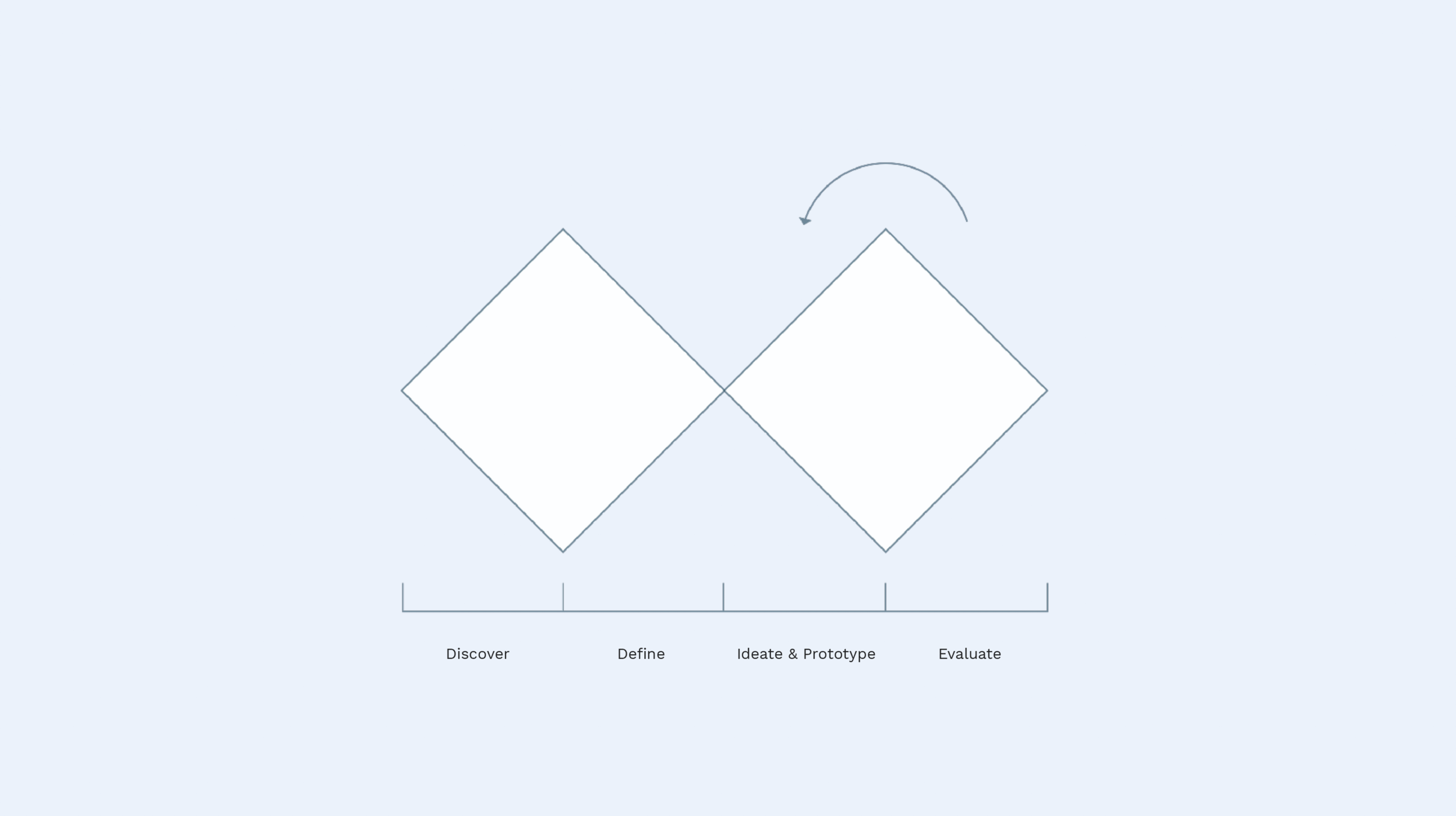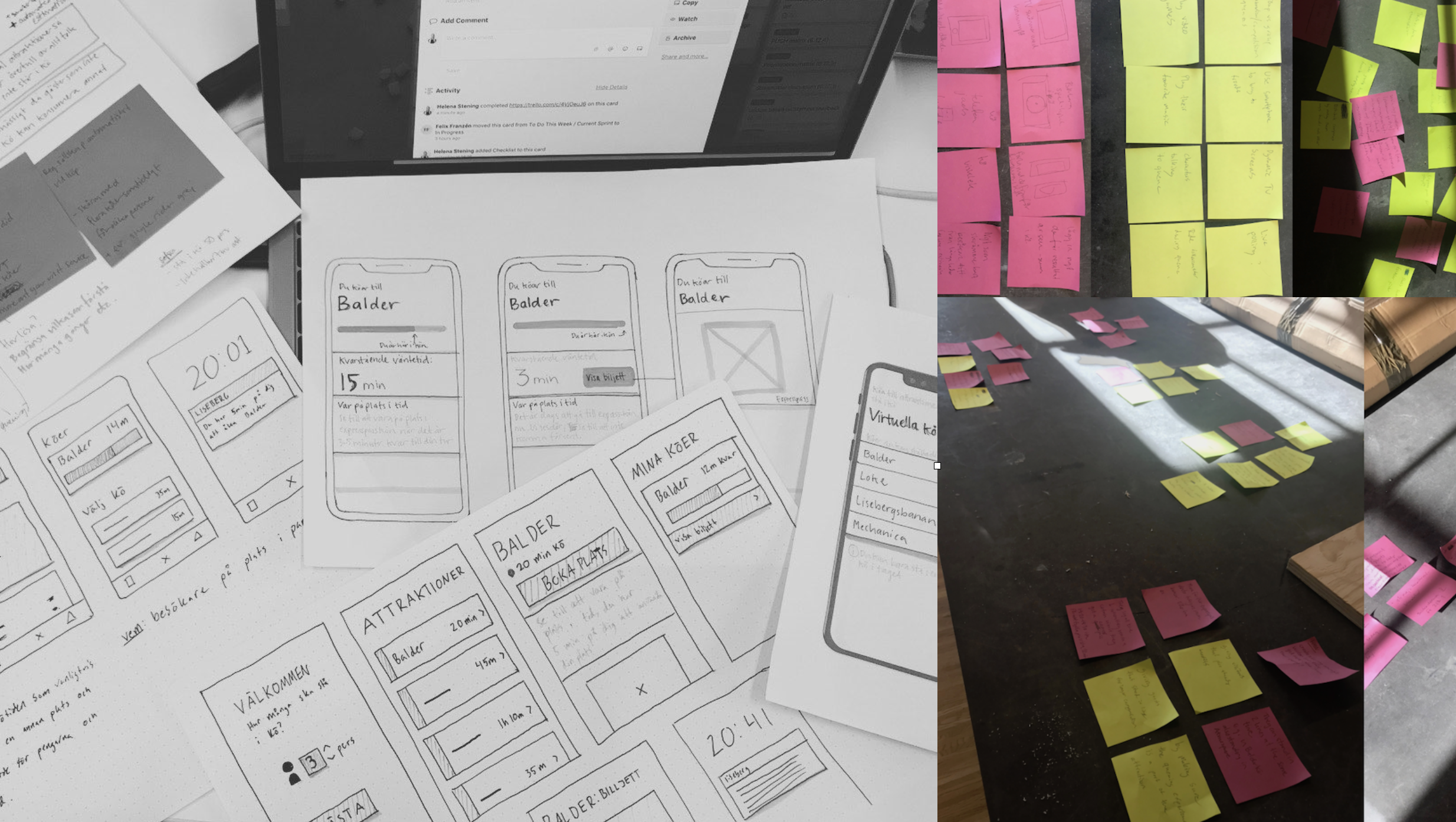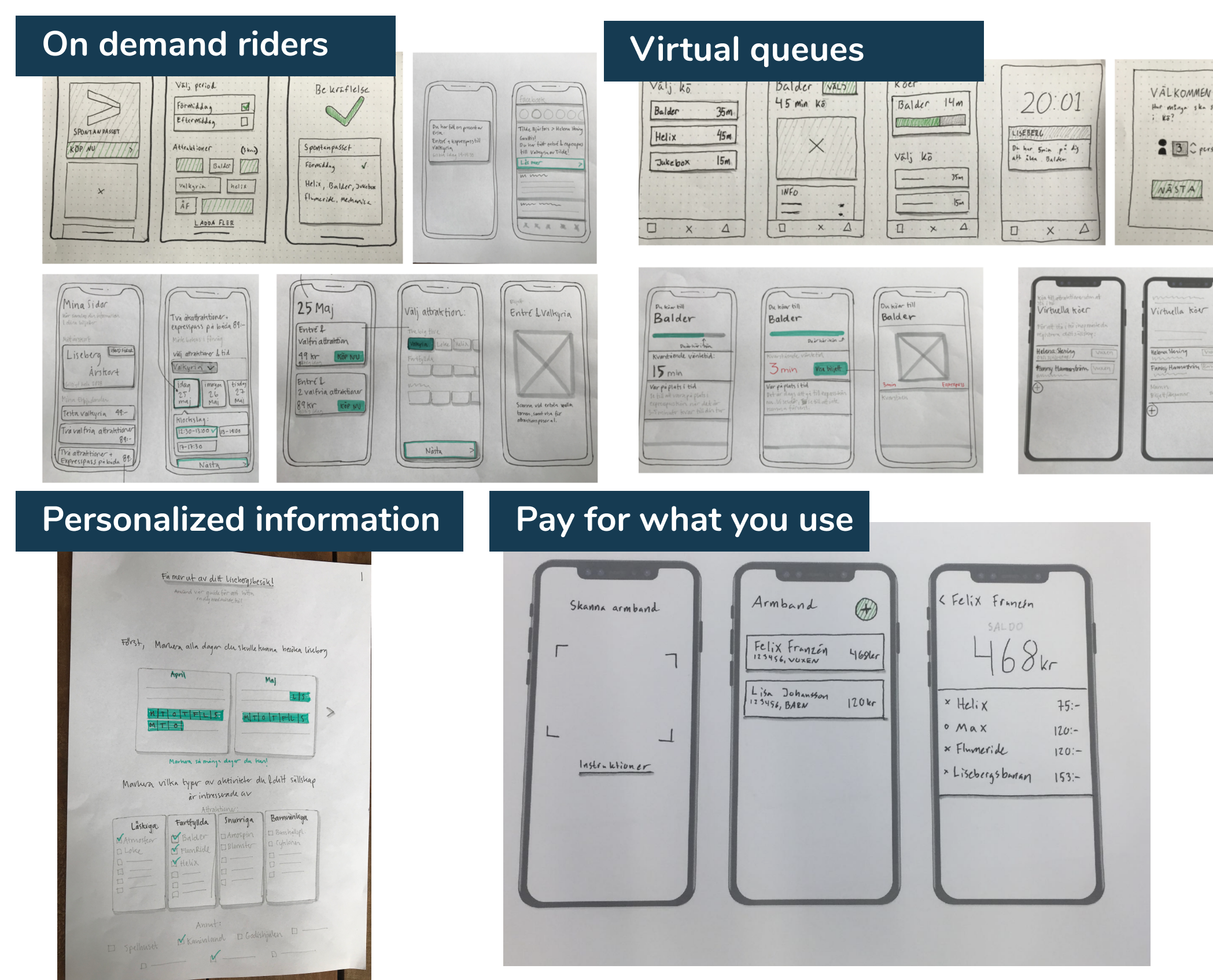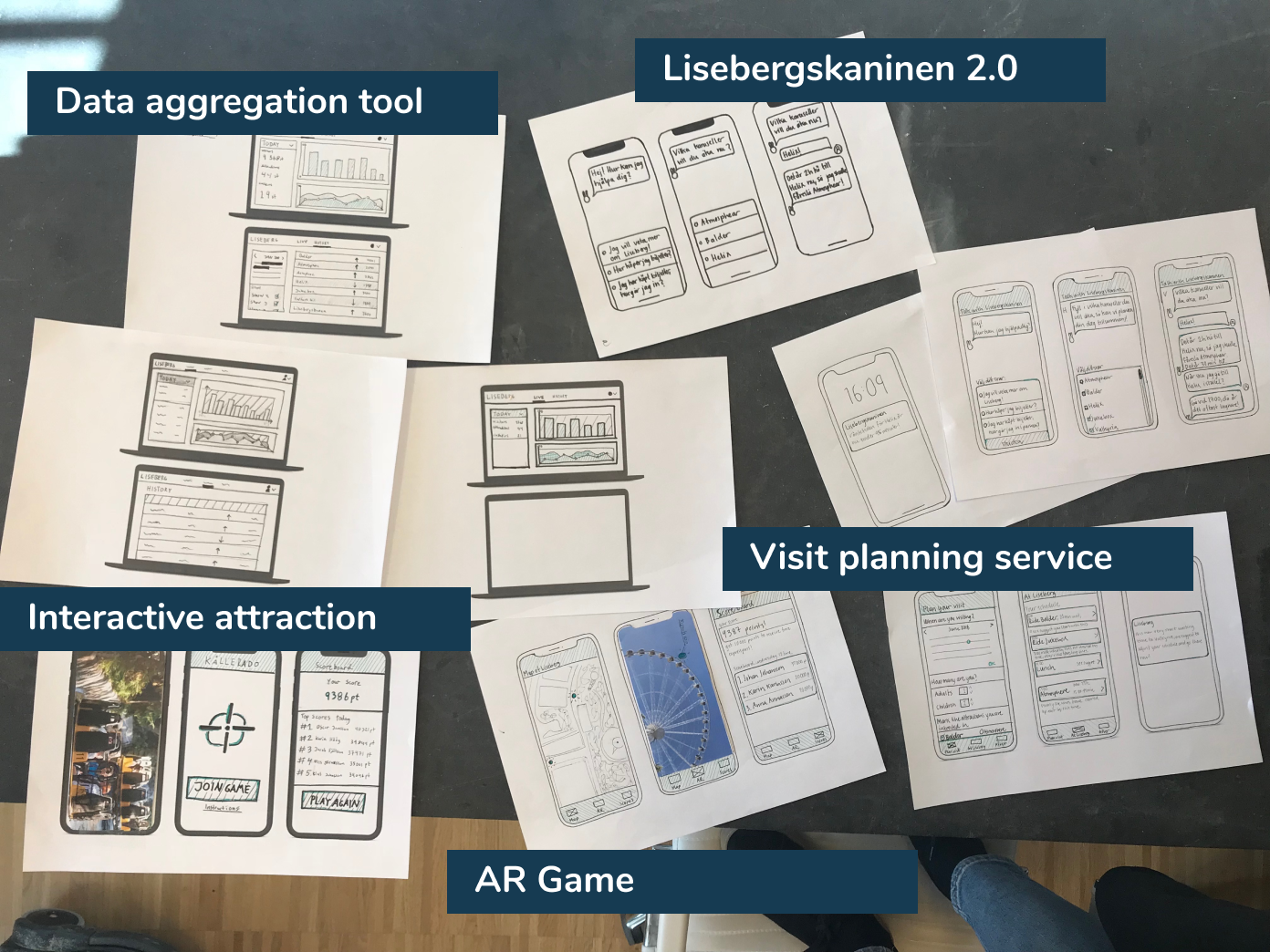Team
Helena Stening - User Research and Product Design
Felix Franzén - User Research and Product Design
Introduction
The final presentation of the entire project can be viewed on youtube.
Imagine the perfect summer day. The sun is shining, you are off from work and just today you feel a bit extra energized. You and some friends have a day planned together at Liseberg, Gothenburg’s amusement park. You enter the gates of the amusement park and are struck by the insanely dense crowd. Fast forward, and you find yourself in a queue, which you have been in for 90 minutes. Your legs and back start to hurt, you already looked through Instagram and it is getting warm. Upon that, you also feel a bit thirsty. The time estimation sign tells you there will be 20 more minutes, but they will most likely feel like 40. We have all been there, and it is impossible to keep up a good mood and not be overwhelmed by restlessness, frustration, and boredom in these situations.
This is why we, Felix Franzén and Helena Stening, decided to focus on the queueing problematics at amusement parks during our Master Thesis project, which is a part of the Interaction Design and Technologies Master program at Chalmers University of Technology. The entire project summary can be viewed on the youtube preview, but if you prefer reading it’s all written on this page as well!
Our main goal, besides answering our research question, was to..:
Explore how the user experience of queuing at amusement parks can be improved through the development of a solution & high-fidelity prototype
Background
The project was planned to follow a version of the Double Diamond.
Additionally to the recognizable problems described in the introduction above, researching amusement parks is interesting on many levels. The amusement park industry is highly global and attracts hundreds of millions of visitors each year. There are a lot of previous research done within the domain, as well as attempts to solve these issues, with a variation on successfulness in the implementations. As we are based in Gothenburg, this area was also extra interesting due to the local amusement park, Liseberg, also struggling with these problems.
Discover: Is queuing a problem, and why?
In order to create an understanding of the domain, multiple initial research methods were used. We performed background research such as literature reviews and benchmarking studies to understand existing issues and solutions within the space. We conducted 14 interviews with guests at Liseberg to understand if queueing to and within the park is painful and what about it that is problematic. Also, we extracted data from Lisebergs previous field surveys to get an understanding and sizing on multiple problem areas. In addition, we held 5 employee interviews and had multiple discussions with Liseberg’s management in order to understand the work performed by Liseberg employees at queue-related services points and collect all information to map out Service Blueprint and Customer Journey Map.
Define: What are the main problems we want to solve?
Through the use of the KJ analysis method, all data was analyzed and summarised into 8 key insights and problem areas. The first one highlights the importance of social interaction, hence this is a main reason for guests visiting amusement parks. Found was also that there currently is an uneven distribution of guests amongst season, weekdays and also attractions which lead to long lines. Also, mismatched expectations and failure to provide accurate estimations affect the users perceived waiting time. Additionally, we identified that the area physical discomfort was important since many guests struggle with this during long waiting times. Further, the lack of conceptual models was found to prevent guests from making smart decisions, hence prolonging the waiting times. Then we also identified that the queues themselves create negative emotions such as boredom or anger. Further, the queueing experience was identified to affect the guests’ feeling of getting their money’s worth. Finally, noticed was also the importance of distractions during waiting, since filled time is perceived as passing quicker than unfilled time.
We also created other artefacts to communicate and capture our insights from the research, such as personas, service blueprints and Customer Journeey Maps (shown below).
The synthesis of all captured data and insights resulted, amongst other artefact, in this Customer Journey Maps for the two Personas we worked with.
Vision Statement
The design and implementation of finalised solution will help users to reach their goal of having an exciting social experience, by allowing them to replace waiting times with meaningful activities as well as positively influence their perception of having an efficient visit.
Problem statement
“During peak season, up to 50% of Liseberg’s guests are dissatisfied with the experience of queuing to attractions. Guests feel that queuing waste time and prevent them from getting value for their money, which results in boredom, irritation, and annoyance. This counteracts the guests’ goal to have an exciting social experience at Liseberg."
Ideate and prototype round 1: How can we solve those problems?
Many initial concept ideas were created through several brainstorming sessions, and these were evaluated through a PUGH matrix and stakeholder discussions. We explored many concepts outside of Virtual Queuing that still addressed some of the identified issues, like a Virtual Rollercoaster app to play while waiting in line to get the time to pass faster. After discussions with the management team and evaluations, a selection of the concept area of Virtual Queueing was made due to its potential to solve the identified problems and address the key insights. Additionally, the format of a mobile application was decided to be the main focus and base for continuous development, since Liseberg currently was developing a new app and we could take the opportunity to make our solution fit seamlessly in that app. We started to create wireframes and iteratively reached a first interactive prototype, built with Framer.
Evaluation: Usability testing round 1
The first prototype was discussed with Liseberg management as well as evaluated in a series of usability tests. The usability test, conducted by 6 test subjects, included tasks to complete with the interactive prototype, such as joining a virtual queue for a certain rollercoaster with the entire family. The testing resulted in a set of issues that needed design improvements, as well as three new insights relating to designing virtual queuing services. These covered the importance of flexibility in such a service, perceived fairness including accessibility as well as the importance of disconnecting from smartphones during these kind of activities.
Three new insights that we took into consideration after the initial usability testing.
Ideate and prototype round 2: Iterate on how to solve the problems better
Based on the new insights and results regarding the prototype’s usability, more brainstorming regarding specific design improvements to the concept and the prototype was conducted. Iteratively, a second improved prototype was developed.
Evaluation round 2: Testing at amusement park
The second prototype was tested in a usability test in context, at Liseberg, with three recruited families, a total of 15 people. The identified issues were considered in the finalized version of the prototype for this thesis project and are displayed below.
Results
The final concept, aiming to improve the user experience of queuing in an amusement park, is a Virtual queuing service. By utilising the service, guests are able to stand in line virtually instead of physically. Consequently, the guests can participate in other activities while still queuing to ride attractions. This service has the potential to improve the queuing experience by making the waiting time more meaningful. Instead of waiting in long physical lines, they are free to roam the park and spend quality time with friends and family.
The guests’ primary touch point with the service is a smart phone application. Here, users can browse and book virtual queue spots at attractions. Furthermore, as a Liseberg visit is a social experience, the application also allows groups of people to virtually queue together. This is done with the functionality of registering and managing a company, by connecting a person’s ride admission wristband to the application, through scanning of the wristbands QR code. The process of using the service is described in the picture below.
Onboarding flow:
Joining a virtual queue:
Other screens such as the notification for when it’s your turn or when an rollercoaster you are in line for have broken down, plus the profile page:
Next steps
In the next step, we think this solution can be developed further to cover more of the key insights we identified, for example Guest distribution, by giving incentives for the local market to visit during preseason, or within the park by suggesting attractions. The app could also help guests to create conceptual models by giving guidance in decision making, helping them queue more efficiently.
A future goal would of course be to completely remove the regular queues. Even if this would require lots of work and testing, we are very confident that queueing will look different in the future and this is one step in the right direction!


















